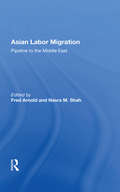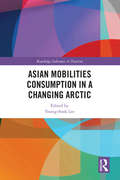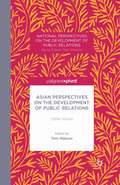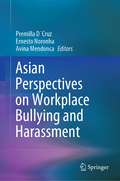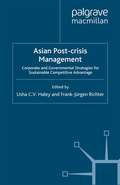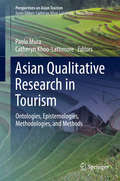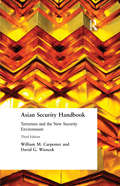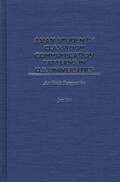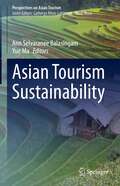- Table View
- List View
Asian Labor Migration: Pipeline To The Middle East
by Fred ArnoldLabor migration from Asia to the oil-exporting countries in the Middle East has burgeoned in the last decade to a current level of over two million workers. Because foreign labor contracts have become a potent source of foreign exchange to the sending countries in Asia as well as a safety valve for high unemployment, the export of labor has become
Asian Labor Migration: Pipeline To The Middle East
by Fred ArnoldLabor migration from Asia to the oil-exporting countries in the Middle East has burgeoned in the last decade to a current level of over two million workers. Because foreign labor contracts have become a potent source of foreign exchange to the sending countries in Asia as well as a safety valve for high unemployment, the export of labor has become
Asian Megatrends
by Rajiv BiswasAsian Megatrends assesses the key drivers impacting Asia over the next two decades. The rise of China is transforming the Asia-Pacific, as China’s economic and military might increasingly reverberates throughout the region. India and Indonesia are also rising Asian powers that are changing the shape of the Asian economic landscape. The rapid growth of emerging Asian consumer markets is becoming an increasingly important growth engine for the world economy and for global multinationals. However, Asia faces tremendous economic and social challenges over the long-term, including the rapid growth of Asian megacities and severe environmental problems due to climate change, water crises and pollution. Geopolitical tensions have also been escalating in the Asia-Pacific due to territorial disputes in the South China Sea and the East China Sea, increasing the risk of a regional arms race and military confrontation.Asian Megatrends is an essential read for government officials and corporate executives wishing to understand the rapidly changing risk landscape in Asia.
Asian Mergers and Acquisitions: Riding the Wave (Wiley Corporate F&A)
by Vikram Chakravarty Soon Ghee ChuaA fascinating look at the unique nature of mergers and acquisitions in Asia The Asian market is heating up, and both local and international firms are looking to get in on the mergers and acquisitions (M&As) that are poised to play a pivotal role in the restructuring of all manner of industries. This restructuring will increase competitiveness, but to make the most of it you need to understand why M&As in Asia are unique. With Asian Mergers and Acquisitions: Riding the Wave in hand, you have everything you need to do just that. Packed with invaluable information on how Asian M&As work, the book points to the fragmented nature of Asian countries, markets, and customers, the rise of Asian economies and firms, and the growth of cross-border business driven by the need for companies to gain access to markets, technologies, and brands as key elements for understanding the market. Lays out guiding principles for Asian M&As, including identifying the drivers for creating value, mitigating cultural differences, getting the best expertise in pre- and post-merger efforts, and more Contains everything investors need to know to understand coming changes in the Asian market Details how Asian M&As differ from those in other countries Providing clear insights into Asian mergers and acquisitions and their inner workings, including do's and don'ts for successful investment, this book is essential reading for anyone looking to cash in—or simply understand— the rapid growth of Asian industry.
Asian Mergers and Acquisitions: Riding the Wave (Wiley Corporate F&A)
by Vikram Chakravarty Soon Ghee ChuaA fascinating look at the unique nature of mergers and acquisitions in Asia The Asian market is heating up, and both local and international firms are looking to get in on the mergers and acquisitions (M&As) that are poised to play a pivotal role in the restructuring of all manner of industries. This restructuring will increase competitiveness, but to make the most of it you need to understand why M&As in Asia are unique. With Asian Mergers and Acquisitions: Riding the Wave in hand, you have everything you need to do just that. Packed with invaluable information on how Asian M&As work, the book points to the fragmented nature of Asian countries, markets, and customers, the rise of Asian economies and firms, and the growth of cross-border business driven by the need for companies to gain access to markets, technologies, and brands as key elements for understanding the market. Lays out guiding principles for Asian M&As, including identifying the drivers for creating value, mitigating cultural differences, getting the best expertise in pre- and post-merger efforts, and more Contains everything investors need to know to understand coming changes in the Asian market Details how Asian M&As differ from those in other countries Providing clear insights into Asian mergers and acquisitions and their inner workings, including do's and don'ts for successful investment, this book is essential reading for anyone looking to cash in—or simply understand— the rapid growth of Asian industry.
The Asian Miracle, Myth, and Mirage: The Economic Slowdown is Here to Stay
by Bernard ArogyaswamyUntil recently, double-digit economic growth was not unusual among Asian countries and, in fact, had come to be expected of them. From western India to northeastern China, markets were booming and incredible numbers of foreign investors were racing into the Asian markets. Scholars have written laudatory books and articles, politicians want to ensure that trade with Asian countries continues on a rising trajectory, and business leaders have become the new promoters of Asian prosperity. This book attempts to inject a note of caution and reality, while giving Asian countries well-deserved credit for improving their economic status.Technological, managerial, and institutional deficiencies need to be addressed in Asian countries if the progress of the past two decades is to be restored and preserved. Although Asian nations, particularly Japan, have invested heavily in R&D, their success mainly derives from process improvements and not from new product innovations. Technology and science are the foundations of modern economic civilization, and Asia's assets fall behind Western countries in both areas. The centrality of family-based organizations in some Asian economies and the dependence on horizontal/vertical networks in others also limits the ability of Asian firms to become global operations. The lack of adequate institutions such as an independent judiciary and a responsive polity, and the absence of organizations to bridge the gap between between familism and the government, results in an uncertain societal framework in much of Asia. If robust economic growth is to return, Asian economies must rectify the weaknesses Arogyaswamy exposes in this provocative and timely book.
Asian Mobilities Consumption in a Changing Arctic (Routledge Advances in Tourism)
by Young-Sook LeeThis book provides an in-depth examination of the growing Asian tourism market and consumption in Arctic destinations. Through five parts, the book covers Asian mobilities consumption as an extension of Arctic international politics, the transportation sector and green cruise tourism, and ethnicity, culture, and history. It contributes to further understanding of the impacts of increased tourism in these polar regions by exploring climate change, debates around emerging economies and global power roles in the political, socio-economic, security and legal issues of the Arctic and Antarctic and associated polar strategies and policy. By drawing on a range of disciplines and with contributions from experts in Arctic destinations or who are associated with the Arctic, it further provides a holistic framing of emerging demand and mobility patterns of Asian tourists in a polar context. Asian Mobilities Consumption in a Changing Arctic will be valuable reading for students and academics across the fields of tourism, economics, sustainability, development studies as well as other social science disciplines.
Asian Mobilities Consumption in a Changing Arctic (Routledge Advances in Tourism)
by Young-Sook LeeThis book provides an in-depth examination of the growing Asian tourism market and consumption in Arctic destinations. Through five parts, the book covers Asian mobilities consumption as an extension of Arctic international politics, the transportation sector and green cruise tourism, and ethnicity, culture, and history. It contributes to further understanding of the impacts of increased tourism in these polar regions by exploring climate change, debates around emerging economies and global power roles in the political, socio-economic, security and legal issues of the Arctic and Antarctic and associated polar strategies and policy. By drawing on a range of disciplines and with contributions from experts in Arctic destinations or who are associated with the Arctic, it further provides a holistic framing of emerging demand and mobility patterns of Asian tourists in a polar context. Asian Mobilities Consumption in a Changing Arctic will be valuable reading for students and academics across the fields of tourism, economics, sustainability, development studies as well as other social science disciplines.
Asian Money Markets
by David C. Cole Hal S. Scott Philip A. WellonsThe countries of East and Southeast Asia have the world's most dynamic money markets. Essential to the Asian economy, their performance plays a crucial role in the successful development of other financial markets, such as those for business and consumer loans. This original study of the effect of government policy on the performance of money markets in the economies of this region (Hong Kong, Indonesia, Japan, Malaysia, the Philippines, Singapore, and South Korea) is the only comprehensive book addressing this topic available today. Individual chapters were written by experts in the field, and were guided by a common research methodology. This book will be of great value to Pacific Basin specialists, bankers, academics, and public policy planners in finance.
Asian Nations and Multinationals: Overcoming the Limits to Growth
by Bernadette Andreosso-O’Callaghan Jacques Jaussaud M. Bruna ZolinAlthough Asia has been the world engine of economic growth since World War II, growth rates have differed sharply among the countries of the region. Still, all Asian countries have experienced some degree of growth limitation. Japan is facing the crucial issue of a quickly aging and shrinking population, a situation that South Korea is bound to face in the near future too. China, which still enjoys relatively high growth rates, is dealing with an exhaustion of its export-led growth model based on low wages, as well as huge and unprecedented environmental problems. In addition, food supply is still a concern for most Asian countries in spite of huge increases in productivity in the agricultural sector, the main reason being that global demand for food products has been increasing at an even higher speed. This edited collection focuses on the policies – at the macroeconomic level – and strategies – at the micro-meso economic levels – that need to be deployed in order to overcome the limits to growth in a post-global financial crisis and export-led growth context. It will be of interest to all scholars of economics, management and the political sciences who work on the economies of East Asia, and also to all those who work on the theme of 'transition economies'.
Asian Perspectives on International Investment Law (Routledge Research in International Economic Law)
by Junji NakagawaWith changes to the international investment law landscape and Asian countries now actively developing their network of bilateral investment treaties (BITs) and free trade agreements (FTAs), this volume studies issues relating to Asian perspectives on international investment law and forecasts the future of Asian contribution to its science and practice. The book discusses the major factors that have been driving Asian countries to new directions in international investment rule-making and dispute settlement. It also looks at whether Asian countries are crafting a new model of international investment law to reflect their specific socio-cultural values. Finally, the book examines whether there are any ‘Asian’ styles of international investment rule-making and dispute settlement, or if individual Asian countries are seeking specific national ‘models’ based on economic structure and geopolitical interests. This unique collection is exceptionally useful to students, scholars and practitioners of international investment law, international trade law and public international law.
Asian Perspectives on International Investment Law (Routledge Research in International Economic Law)
by Junji NakagawaWith changes to the international investment law landscape and Asian countries now actively developing their network of bilateral investment treaties (BITs) and free trade agreements (FTAs), this volume studies issues relating to Asian perspectives on international investment law and forecasts the future of Asian contribution to its science and practice. The book discusses the major factors that have been driving Asian countries to new directions in international investment rule-making and dispute settlement. It also looks at whether Asian countries are crafting a new model of international investment law to reflect their specific socio-cultural values. Finally, the book examines whether there are any ‘Asian’ styles of international investment rule-making and dispute settlement, or if individual Asian countries are seeking specific national ‘models’ based on economic structure and geopolitical interests. This unique collection is exceptionally useful to students, scholars and practitioners of international investment law, international trade law and public international law.
Asian Perspectives on the Development of Public Relations: Other Voices (National Perspectives on the Development of Public Relations)
by Tom WatsonThe National Perspectives on the Development of Public Relations: Other Voices series is the first to offer an authentic world-wide view of the history of public relations. It will feature six books, five of which will cover continental and regional groups. This first book in the series focuses on Asia and Australasia.
Asian Perspectives on Workplace Bullying and Harassment
by Premilla D’Cruz Ernesto Noronha Avina MendoncaThis book showcases empirical studies on workplace bullying from a range of Asian countries, including China, India, Indonesia, Israel, Japan, Jordan, Malaysia, Pakistan, Singapore, South Korea, Sri Lanka, Thailand, UAE and Vietnam, and is the first-of-its-kind single academic project documenting workplace emotional abuse in the world’s largest continent. It encompasses the ‘varieties of workplace bullying’ conceptualization in addition to category-based harassment and abusive supervision, and presents target, bystander and interventionist perspectives, along with contextualized insights into the phenomenon. The book speaks to the significance of sociocultural factors and draws on several theoretical and substantive bases including dignity, social cynicism, coping, gender, sexual orientation, job insecurity, turnover intention, affective events theory, attribution theory, regulation and policy initiatives. Covering all major regions in Asia where workplace bullying has been found to occur, namely West Asia, South Asia, Southeast Asia and East Asia, the book portrays studies which engage both positivist and postpositivist paradigms, utilize an array of methods and include a range of industrial sectors and employment contracts and all levels of the organization. While focused on Asia, the book’s insights have international relevance and are of interest to the worldwide community of researchers, practitioners and students of organizational studies, human resource management, industrial sociology, work psychology, industrial relations, labour law, corporate law, health sciences, social work and Asian studies.
Asian Post-crisis Management: Corporate and Governmental Strategies for Sustainable Competitive Advantage
by U. Haley F. RichterThis book examines the key issues faced by the managers of multinational companies, and contains cutting-edge strategies and practices designed to enable managers and policy makers to weather the Asian financial and economic storms. Asian Post-Crisis Management shows how to position companies and governments in Asia for sustainable competitive advantage, and will be of interest to top management leaders, senior economic analysts, policy makers, academic scholars and students of international management.
Asian Qualitative Research in Tourism: Ontologies, Epistemologies, Methodologies, and Methods (Perspectives on Asian Tourism)
by Paolo Mura Catheryn Khoo-LattimoreThis book explores the ontologies, epistemologies, methodologies, and methods that inform tourism qualitative research conducted either by Asian scholars or non-Asian scholars focusing on Asia. In addition to providing a platform for researchers to publish their qualitative journeys, it aims to encourage further Asian qualitative tourism research production.The book not only includes chapters from Asian scholars but also non-Asian tourism researchers with a focus on Asia, as their chapters are crucial to represent the multiplicity of realities constituting ‘Asia’. It is of interest to the whole tourism academic community as it provides novel methodological insights from a non-Western perspective, which at the moment are often silenced by dominant (Western) voices.
Asian Security Handbook: Terrorism and the New Security Environment
by William M. Carpenter David G. Wiencek James R. LilleyThis thoroughly revised and updated edition of Asian Security Handbook focuses on the new challenges to security in the Asia-Pacific region presented by international terrorism. It reviews old security realities covered in previous editions, and highlights more recent security issues in the region, including the North Korean threat, weapons of mass destruction proliferation, the South China Sea dispute, and the future U.S.-China rivalry. Featuring contributions by a distinguished group of international security and Asia experts, this new edition has been reformatted and restructured. A new introductory chapter on terrorism sets the stage for the country-by-country profiles and assessments of the political-security situations in twenty-three individual nations. A new appendix on foreign terrorist organizations is also included.
Asian Security Handbook: Terrorism and the New Security Environment
by William M. Carpenter David G. Wiencek James R. LilleyThis thoroughly revised and updated edition of Asian Security Handbook focuses on the new challenges to security in the Asia-Pacific region presented by international terrorism. It reviews old security realities covered in previous editions, and highlights more recent security issues in the region, including the North Korean threat, weapons of mass destruction proliferation, the South China Sea dispute, and the future U.S.-China rivalry. Featuring contributions by a distinguished group of international security and Asia experts, this new edition has been reformatted and restructured. A new introductory chapter on terrorism sets the stage for the country-by-country profiles and assessments of the political-security situations in twenty-three individual nations. A new appendix on foreign terrorist organizations is also included.
Asian Students' Classroom Communication Patterns in U.S. Universities: An Emic Perspective (Contemporary Studies in Second Language Learning)
by Jun LiuThe past decade has witnessed a steady increase in the numbers of Asian students in North American institutions of higher learning. While their academic success has been widely recognized, concerns about their silence in classrooms have also been expressed by educators. Following an overview of Asian students in North American higher education, this book presents a focused ethnographic study of twenty Asian graduate students enrolled in a major US university, exploring and describing Asian student's oral classroom participation modes across multiple factors.Four major classroom communication patterns--total integration, conditional interaction, marginal participation, and silent observation--are identified among the participants and discussed across sociocultural, affective, cognitive, linguistic, and pedagogical/environmental factors. Also discussed are the Asian concepts of face saving, politeness, and social identity in multiple discourse communities in light of Asian students' perceptions of and modes in classroom participation. The book concludes with a call for the development of cultural transformation competence, which encompasses social identity negotiation skills, and culture-sensitivity knowledge and mindful reflexivity in addition to communicative competence.
Asian Tourism: Growth And Change (Advances in Tourism Research)
by Janet CochraneTourism in Asia is growing faster than anywhere else in the world, driven by the increasing wealth of countries like Taiwan, South Korea and Malaysia, and by the huge populations of China, India and Indonesia -the first second and fourth biggest countries in the works. Despite the significance of the tourism industry in this area it is still under researched. Asian Tourism is a unique book and the first to addresses this imbalance by providing a high quality edited collection of chapters which explore the domestic and intraregional tourism in Asia. Divided into three sections it explores:* Policy aspects of tourism development and the role of the public sector exploring issues such as: Cross-national tourism collaboration in Asia, The growth of aviation in Asia and Economic Corridors and Ecotourism.* Changing markets exploring issues such as: The role of Japanese popular culture in Asian tourism, Management Challenges for Bali’s Tourism Industry and religious tourism in North India.* Destination and industry responses exploring issues such as: Tourism-Generated Employment in Cambodia, sex workers and tourism in India and responsible destination development in the Philippines.With contributions from well respected and eminent names in the field, Asian Tourism provides a ground breaking insight into topical, industry focused issues while benefiting from academic depth and rigour and an awareness of tourism history in this region.
Asian Tourism: Growth and Change
by Janet CochraneTourism in Asia is growing faster than anywhere else in the world, driven by the increasing wealth of countries like Taiwan, South Korea and Malaysia, and by the huge populations of China, India and Indonesia -the first second and fourth biggest countries in the works. Despite the significance of the tourism industry in this area it is still under researched. Asian Tourism is a unique book and the first to addresses this imbalance by providing a high quality edited collection of chapters which explore the domestic and intraregional tourism in Asia. Divided into three sections it explores:* Policy aspects of tourism development and the role of the public sector exploring issues such as: Cross-national tourism collaboration in Asia, The growth of aviation in Asia and Economic Corridors and Ecotourism.* Changing markets exploring issues such as: The role of Japanese popular culture in Asian tourism, Management Challenges for Bali’s Tourism Industry and religious tourism in North India.* Destination and industry responses exploring issues such as: Tourism-Generated Employment in Cambodia, sex workers and tourism in India and responsible destination development in the Philippines.With contributions from well respected and eminent names in the field, Asian Tourism provides a ground breaking insight into topical, industry focused issues while benefiting from academic depth and rigour and an awareness of tourism history in this region.
Asian Tourism Sustainability (Perspectives on Asian Tourism)
by Ann Selvaranee Balasingam Yue MaThis book brings together a collection of chapters that investigate sustainable tourism development in different Asian contexts; from stakeholders’ perspectives, existing issues in the market, as well as the impacts of COVID-19 on tourism. It highlights the importance of tourism sustainability in Asia. Specifically, this book examines these themes by examples related to Asian tourism such as; social-cultural impact of sustainable growth, environmental constraints and policies, community engagement, moral limits of the market, stakeholders’ participation in tourism development, the hindered interaction between foreign tourists and local community, impact of the pandemic and proposed ways forward. This edited volume substantiates this by using evidence of quantitative, qualitative and mixed methods approaches aligned with empirical data to show sustainable efforts and impacts. This book is of interest to researchers and practitioners as it offers timely understandings of sustainable tourism from multiple perspectives within the Asian context.
Asian Trade and European Influence: In the Indonesian Archipelago between 1500 and about 1630
by M. A. Meilink-RoelofszNow that this study is completed and I wish to make due acknowledg ment to all those who have in any degree contributed towards its realization, my thoughts turn in the first place to the one to whom this book is dedicated. It is a great grief to me that he who took such an intense interest in my work has not lived to see its conclusion. It was he who in the beginning urged me to venture upon this course of study and whose encouragement helped me in moments of de spondency. The high standard which, with his keen and critical judgment, he set for his own work, was an example to me, and I shall strive to maintain it in my future studies. Not only did he help me to lay the foundation of my knowledge of archive science, but he was also my guide in a field new to me in many respects, that of Asian maritime trade. His wide knowledge of medieval European trade in the Baltic area led me to compare and contrast the two worlds of East and West and thus helped me to obtain a deeper insight into the differences and similarities between the various problems involved. I am greatly indebted to Prof. Dr. J. M. Romein, who has followed the progress of my studies with great interest all these years, and on whose help and support, sometimes in very difficult circumstances, I have always been able to rely.
Asian Trade and Investment in Europe (Routledge Studies in the Modern World Economy)
by Prana Krishna Biswas Robert DygasThis book provides deep insight into the flow of foreign direct investment from Asia to Europe. It assesses the topic of trade and investment from the reverse direction, considering Asian countries as the capital investors in the EU countries. Each chapter analyses either the international trade or investment of one or more Asian countries in correlation with one or more European states. The book analyses a significant number of countries, which are included in various economic associations, such as the Visegrad Group, the Three Seas Initiative, the European Free Trade Association, or are states from the same geopolitical region – for instance, the Iberian Peninsula, Baltic States, and Nordic countries. It examines Indian outward foreign direct investment trends in the UK before and after Brexit, based on select case studies, to emphasize the impact of Brexit, as well as to encourage trade and investment among Asian and European countries before and during COVID-19, to highlight the influence of the pandemic on the target country’s economy. The authors use a variety of analytical methods in the book, such as numerical presentations, econometric analysis, descriptive statistical analysis, an examination of time-series dynamics, the modelling of functions, and semi-structured interviews with company executives. The regional perspectives bring new and useful insights to the topic, and the case study approach allows for a wider exploration of the research questions as well as their theoretical evolution. The book provides a "big picture" for economists, researchers, business analysts, and PhD students of economics, international trade, and business.
Asian Trade and Investment in Europe (Routledge Studies in the Modern World Economy)
by Prana Krishna Biswas Robert DygasThis book provides deep insight into the flow of foreign direct investment from Asia to Europe. It assesses the topic of trade and investment from the reverse direction, considering Asian countries as the capital investors in the EU countries. Each chapter analyses either the international trade or investment of one or more Asian countries in correlation with one or more European states. The book analyses a significant number of countries, which are included in various economic associations, such as the Visegrad Group, the Three Seas Initiative, the European Free Trade Association, or are states from the same geopolitical region – for instance, the Iberian Peninsula, Baltic States, and Nordic countries. It examines Indian outward foreign direct investment trends in the UK before and after Brexit, based on select case studies, to emphasize the impact of Brexit, as well as to encourage trade and investment among Asian and European countries before and during COVID-19, to highlight the influence of the pandemic on the target country’s economy. The authors use a variety of analytical methods in the book, such as numerical presentations, econometric analysis, descriptive statistical analysis, an examination of time-series dynamics, the modelling of functions, and semi-structured interviews with company executives. The regional perspectives bring new and useful insights to the topic, and the case study approach allows for a wider exploration of the research questions as well as their theoretical evolution. The book provides a "big picture" for economists, researchers, business analysts, and PhD students of economics, international trade, and business.
